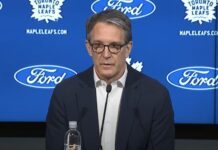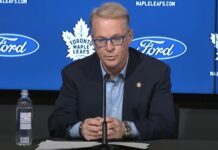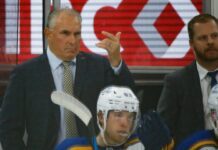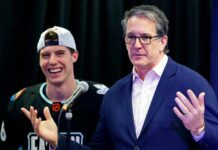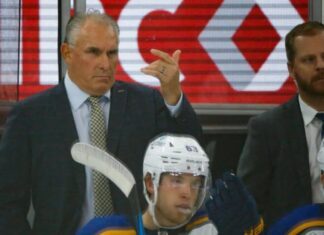If you watched Brendan Shanahan’s end of season press conference and began wondering who the next GM will be, you missed the forest for the trees.
It was pretty clear last season, and abundantly clear now, that Brendan Shanahan is the GM of the Toronto Maple Leafs.
Traditionally there is confusion when teams don’t have a GM in place because now the incumbent staff is reporting to a president or ownership group that is not a hockey expert. That is not the case here. Shanahan could go into the draft and free agency tomorrow and not miss a beat. He has not defined his plan or vision –and it appears he won’t at all—but it is in his vision and plan that this team will be built.
“We want someone that shares our vision,” said Shanahan. “We need to have a team with greater character. We have to have people that represent this city and represent this team as it deserves. I think we have an incredibly loyal, resilient fanbase. We need to have an incredibly resilient group of players that love to play in Toronto… This job won’t be for some general managers, but those general managers won’t be for us. The one statement I don’t like to say too much is this is how it’s always been done. That doesn’t really make much sense to me. I believe we are building a very capable and dedicated staff of people. The type of general manager that I want to bring to Toronto is someone that recognizes that. And wants to be apart of that team.”
Those aren’t the words of someone hiring a GM to run the show.
The usual definition and duties of a GM is a team executive responsible for acquiring the rights to player personnel, negotiating their contracts, reassigning or dismissing players, and hiring and firing coaches.
In one season, Shanahan has negotiated contracts for players such as Casey Bailey, been a key staple in the Roman Polak trade negotiation, hired all of the Leafs assistant coaches and subsequently fired them after the season, and is looking to hire the new head coach. He openly admitted he’d have no problem hiring a head coach before GM, because the reality is he is the GM.
The prototypical management tree in the NHL with the GM in charge is how Brian Burke built his group.
Now it looks like this:
Short of bringing in an experienced voice (or in other words not Rob Blake or someone of that ilk), the move is not inconsequential but the impact made by the GM will not be people what are used to.
At best, they are bringing in another intelligent voice to complement the existing managerial group; at worst, they are bringing in a PR guy to handle all the interviews for Shanahan and take care of the public image. The GM is going to take care of the day-to-day work and logistics of the jobs, but the Leafs aren’t hiring a GM with a vision of how he wants the team to look and how it is going to get there, because as Shanahan has clearly stated, he’s made those decisions.
One interesting thing Shanahan noted in his pressernin this regard, to me, was when he discussed the media and sticking to the plan. “The challenge here in Toronto is not to come up with the plan. The challenge in Toronto is to stick to it. That’s the hard part… As far as having the patience to do what’s needed to be done, yeah, you have to have a stomach in order to get through it in a place with this much passion. I have that stomach. And the board does.”
And with Shanahan not “technically” being GM, it won’t be him answering the questions from the media or facing the heat, and instead he will be sticking to his plan, without the distractions or the screams of the public, presumably.
Just last week Shanahan was lambasted by Bob McCown for cancelling his appearance on PTS with McCown, who stated he has only been on once with him — the day he was hired. All year the players were all over the papers due to various scandals and not once did Shanahan step up in the media to protect the team or shift the attention, perhaps because he felt no affiliation with the group and wanted to tank. He’s rarely done any interviews and has publicly said he feels no need to state his plan publicly because other teams don’t (which is a joke, because pretty well every GM gives at least some sort of indication of what their plan is other than “draft and develop”).
The assumption here is the new “GM” will take care of some of those media appearances now, as well as offer his insight into their decisions, use his connections, and take care of the daily duties of the GM. But make no mistake, the decisions come and go through Shanahan. If it wasn’t clear last summer, it is now—This is his show.
A True Rebuild
As the summer progresses one theme that is sure to come up with regularity is rebuilding and how long it will take. Some analysts and media have already said they believe it will take nearly seven years, but is that realistic?
NHL rosters turn over a lot quicker than most people realize. I took some time to put together a chart that shows the roster turnover from teams from the 2011-2012 campaign and the 2014-2015 that just occurred. I looked at the top 25 players on each team in terms of games played – not including goalies—to see how many have changed in the three seasons since:
| Team | Roster Turnover | Percent |
|---|---|---|
| Anaheim | 17/25 | 68% |
| Arizona | 16/25 | 64% |
| Boston | 15/25 | 60% |
| Buffalo | 18/25 | 72% |
| Calgary | 18/25 | 72% |
| Carolina | 17/25 | 68% |
| Chicago | 13/25 | 52% |
| Colorado | 18/25 | 72% |
| Columbus | 17/25 | 68% |
| Dallas | 19/25 | 76% |
| Detroit | 25-Dec | 48% |
| Edmonton | 20/25 | 80% |
| Florida | 18/25 | 72% |
| Los Angeles | 25-Dec | 48% |
| Minnesota | 20/25 | 80% |
| Montreal | 19/25 | 76% |
| Nashville | 18/25 | 72% |
| New Jersey | 16/25 | 64% |
| NYI | 16/25 | 64% |
| NYR | 19/25 | 76% |
| Ottawa | 16/25 | 64% |
| Philadelphia | 16/25 | 64% |
| Pittsburgh | 17/25 | 68% |
| San Jose | 15/25 | 60% |
| St. Louis | 14/25 | 56% |
| Tampa Bay | 21/25 | 84% |
| Toronto | 18/25 | 72% |
| Vancouver | 15/25 | 60% |
| Washington | 14/25 | 56% |
| Winnipeg | 14/25 | 56% |
| AVERAGE | 16.6/25 | 66.40% |
So, in three seasons teams on average turnover over 66% of their primary playing roster, nearly 17 players, but it should take the Leafs double that time to rebuild?
That is hardly the case.
Just last summer the Vancouver Canucks traded Ryan Kesler because they were heading into a rebuild and he wanted to win. The Canucks made the playoffs this season. The Ottawa traded Jason Spezza because he wanted to win and not play on a budget team. Ottawa made the playoffs season and the team Spezza was traded to, who was one of the league darlings last year, missed.
Things change extremely quickly in this league.
Here is an article that looks at different team rebuilds, where you can see it took teams 3-5 years since the start to make the playoffs.
[quote_box_center]“A commonality in the success examples above is that each team made the playoffs within 5 years from their first top 5 pick (average: 4.25 years). While it’s not a huge sample, it’s a decent measuring stick. There also seems to be another cut-off at around that 6 year mark for making the Conference Finals. If the team doesn’t take that next step by then, they might plateau or see a bit of a regression.”[/quote_box_center]
The Leafs drafted Rielly fifth overall in 2012. Nylander is a top 10 pick that looks like he should have gone even higher if early indications mean anything.
If and when they trade some of their big ticket veterans they are sure to receive value in return. There are a few prospects of note coming through the system other than Nylander as well.
It will take years to build up the prospect pipeline, simply because when you draft kids at 18 they generally only come into the NHL conversation 2-3 years later. The 5-7 year timeline for contention can be appropriate in this regard, unless you get some big breaks. Should the rebuild of the roster and being a competitive playoff team take that long, though?
No way. Unless you’re the Edmonton Oilers.
Best Player Available in the Draft
When it comes to the draft, the moniker is always take the best player available.
That puts the Leafs in an interesting predicament.
With the Oilers winning the draft lottery that means Arizona might possibly draft Dylan Strome instead of what was the general consensus third overall pick most of the year in Noah Hanifin. It was a rumour going around hockey prior to the lottery and is now starting to gain steam within the Arizona media.
Az Coyotes need to draft 6-3 C Dylan Strome, who led OHL in scoring with 45 goals and 128 pts, better than Erie teammate Connor McDavid.
— Bob McManaman (@azbobbymac) April 19, 2015
That would leave Toronto with a decision to make between Hanifin and Mitch Marner (in theory).
The smart money would be on Noah Hanifin based on scouting reports throughout the season, as he has been the consensus third overall choice generally speaking. If they are ranked essentially even though, is it the smart money to draft Hanifin?
When draft boards are being built they are generally done so two ways. You rank each player by position at first (C, LW, RW, LD, RD, G), then you rank them on an overall big board. When you build that board position comes into play to a degree because the gap between players is not always clear cut; let’s face it, if you give two players the same grade, a right handed center has substantially more value than a left winger.
In saying that, Hanifin is a left-handed defenseman. Save for being a superstar (see Ekblad, Doughty, etc.), it takes defensemen roughly 300 games to develop, or essentially four seasons. It is extremely difficult position to learn and play.
Strangely though, here is the list of top four defensemen set for unrestricted free agency this summer, in no particular order:
- Christian Ehrhoff
- Cody Franson
- Andrej Sekera
- Jeff Petry
- Mike Green
- Paul Martin
- Francois Beauchemin
- Zbynek Michalek
- Johnny Oduya
Along with a few other veterans that could probably still handle it (Jan Hejda, Lubomir Visnovsky, and Marek Zidlicky).
Last summer these defensemen switched teams:
- Matt Niskanen
- Christian Ehrhoff
- Anton Stralman
- Tom Gilbert
- Mark Fayne
- Brooks Orpik
- Willie Mitchell
- Michael Del Zotto
Not to mention the countless defensemen who have changed hands lately. And it’s not just veterans either, young guys like Nick Leddy and Brandon Dillon have been traded, Johnny Boychuk and Braydon Coburn as well just to name a few.
Now if you think Mitch Marner is a center –and there is debate on that, he played it quite a bit in the playoffs but not always during the regular season—then looking around the center movement around the league is pretty scary.
Here is the list of top 6 centers set to become UFAs this summer:
- Antoine Vermette.
- Mike Fisher
Here is the list from last summer:
- Mike Ribeiro
- Paul Stastny
- Brad Richards
The trade market has been a little better, with Ryan Kesler and Jason Spezza moving last summer.
On the whole, these guys simply do not get moved or are allowed to hit free agency anymore. That is not the case on defence, where it is relatively quick to patch together more than a talented unit capable of holding their own.
If the scouting report says Hanifin is a top pairing defenseman and Mitch Marner is a top six forward, there is no real debate to be had, obviously. But if the differences are negligible and the report on Hanifin is more of a top four defenseman than a top pairing guy, then alternative players should be explored. Defensemen take longer to develop, top four defensemen are available every summer (for some reason), and forwards are able to step into the league and at least put up points relatively quickly.
This debate is just getting started, but it is something to consider.
William Nylander
Speaking of forwards that are able to step right in and contribute, consider William Nylander. He played 37 games and scored 14 goals on 73 shots with 32 points total. The Marlies are 23-11-3 in games he has played and he’s been a big part of their turnaround to make the playoffs.
At the start of the year, I wrote that the Leafs should have sent Nylander to the AHL when they sent him to Sweden. The general response was basically that he’d get physically crushed in the AHL and to keep him away from the Toronto fishbowl. Well, he put up nearly a PPG as an 18 year old in the league and played there throughout one of the most embarrassing stretches in Leafs history. Somehow, someway, he survived.
AHL success at 18 in no way means he is destined for great things in the NHL (paging Nikita Filatov), but this has been a promising start for the electrifying player that almost certainly looks like a winger at this point, as he’s played there the entire time.
It would have been nice for Nylander to get the entire season in the AHL as was apparent back in October, but the important thing is he has had an extended experience on North American ice against pros to ready him for the NHL.
Discussed in this space regularly down the stretch, the Leafs could have called Nylander up and probably received a nice shot in the arm from him, but they kept him in the AHL and made the playoffs, and also bettered their draft pick in the process.
Win-win. The best part is that the Leafs should have a player ready to contribute to the team at the beginning of next season.
Scouting Systems
There was some talk and worry around Leafs Nation that the Leafs firing all their scouts before the draft could result in some leaked information. That is not how scouting and drafting works, especially when you are an area scout.
Here is a quote from Lou Lamoriello from Behind The Moves on the protection of information and scouting:
“How do we protect [the intellectual property of the Devils]? You trust. You break people up… People can leave with what they know, but not with what somebody else knows. So the way we operate is to have very little interaction with people… The way our [organizational] pyramid is [set up is] a little different than most… Some of your most intelligent scouts might be the most insecure people, so they won’t express themselves if you are overpowering… So we try to do things in such a way that everybody can maximize who they are and never feel that they’re threatened or intimidated or that their opinion is not respected and honoured, even [if] it’s not used.”
Damien Cox noted that the Leafs fired the scouts after they submitted their final reports, which means the team took their information and let them leave with it too, but they didn’t let them leave with the overall group’s information as pre-draft meetings have not really begun to heat up.
It’s a ruthless business and cut throat move, but the Leafs benefit here from collecting reports.
When they are doing their “GM” search, they would be smart to interview as many strong candidates as possible in order to at least attempt to solicit as many ideas and information as possible. It could potentially turn into a great opportunity to gauge the feeling and thoughts of people around the league on players such as Phil Kessel, Tyler Bozak and Dion Phaneuf.
Quotes
That group, in our mind as a coaching staff, we felt that they had to be able to have the freedom to skate, because they’re a skating hockey club, they’re a transition hockey club. And believe me, we tried to preach defence in a lot of areas, but we felt that we had good enough goaltending and if we could transition the puck, then we could be an effective, dangerous hockey club. They weren’t going to be a shutdown team, that group is not prepared to be a shutdown team. That’s maximizing the strength of your roster and what you have. You have to find a way to get people, the people that you have in place, and use them to their strengths and put something in place that will give them the best chance for success.
- Randy Carlyle, on the style of play the Leafs players wanted.
It was pretty clear down the stretch if things weren’t easy and they couldn’t free wheel and score, the players on the team as-is had about zero interest in doing anything the right way that is conducive to winning hockey.
Ultimately, this team had to change. If we continue right where we were in November we might not make the playoffs, we might be fighting for the playoffs. If you’re in that situation, even if we make the playoffs, we’re not going to win. Is that what we want? Do we want to be competitive or do we want to build something to win a Stanley Cup? That’s the change that we have to make. Not to just be competitive. We have to start to think about winning, and have higher expectations. Our expectations have to go in a new direction. Not competitive. That’s just not OK. That’s ultimately where we were. It was the same place where it was the year before.
- Peter Horachek, after his last game coaching the Leafs.
This quote goes hand-in-hand with the Carlyle quote above it. Loud and clear changes need to take place here. It was last summer too.
I think we’ve got some good pieces. But we have some talented parts of this team. As a group, as a mix, they understand and they’ve shown over the years, not just this year, for whatever reason the mix doesn’t work. In spite of the fact we have talented individuals, if the mix doesn’t work, there is going to be changes.
- Brendan Shanahan, on the current team.
Who he keeps will be as much of a statement on that player’s abilities as it is how much that player wants to stay in Toronto and be a Leaf.
Final Note
I just wanted to extend a quick thank-you to everyone for following along this season. Obviously, it was a tough season for the Leafs. At points it was tough to write this column because of how poor they played. However, it was still a great season here with a lot of intelligent and polite discussion, and I always look forward to reading through the comments or getting nice emails. So, once again, thank you for reading and your support. It means a lot to me.



